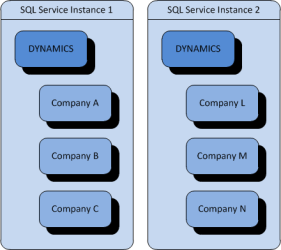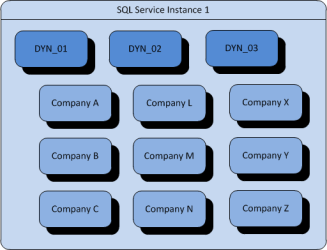 Microsoft have recently been expanding on the roadmap for Microsoft Dynamics GP “12” (expected to be launched as Microsoft Dynamics GP 2012). One of the features which most interests me is the Named System Database Architecture.
Microsoft have recently been expanding on the roadmap for Microsoft Dynamics GP “12” (expected to be launched as Microsoft Dynamics GP 2012). One of the features which most interests me is the Named System Database Architecture.
With Microsoft Dynamics GP 2010, and earlier, you can only have a single DYNAMICS system database with multiple companies on the same SQL Server instance. If you’re a parter supplying hosting then this means multiple system databases are required for multiple customers, as shown in the figure below;

Requiring a different SQL Server instance for each client system is resource intensive but, unfortunately, not possible due to the DYNAMICS system database. Not possible with GP 2010; but possible with Microsoft Dynamics GP “12” and the new Named System Database Architecture.
This feature will enable multiple system databases by allowing for the naming of the system database during installation, which will configure the system to use the name specified for the system database with the applications using this setting to complete the setup and connect to the appropriate database at runtime. This ability is likely to be an advanced installation option, with the majority of system still being installed with a DYNAMICS database to avoid unnecessary complexity where only one system is required.
The figure below shows the possibilities with Named System Database Architecture;

Three named databases each with multiple companies attached to them. Previously, this would require three SQL Server instances with all of the overhead (both time and money) that entails but now can be accomplished by one SQL Server.
This is a very ambitious undertaking by Microsoft which will require a number of changes throughout the current business logic of Microsoft Dynamics GP; the DYNAMICS system database is embedded as a constant in Dynamics GP Utilities and the application directory. A large number of stored procedures exist at the SQL Server level with direct references to a DYNAMICS system database.
As well as the changes Microsoft will need to make, there are also hundreds, perhaps even thousands, of ISV products which will also needed to be amended to function correctly with a database named other than DYNAMICS.
But with this change, combined with the upcoming Dynamics GP Web Client, the first step towards GP in the cloud will be made.
What should we write about next?
If there is a topic which fits the typical ones of this site, which you would like to see me write about, please use the form, below, to submit your idea.




